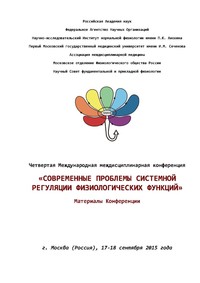СИСТЕМНЫЕ МЕХАНИЗМЫ ИНДИВИДУАЛЬНОЙ СТРЕСС-УСТОЙЧИВОСТИ У ЭКСПЕРИМЕНТАЛЬНЫХ ЖИВОТНЫХ ПРИ СТРЕССАХ РАЗЛИЧНОЙ МОДАЛЬНОСТИ
Бесплатно
Основная коллекция

Издательство:
НИЦ ИНФРА-М
Год издания: 2017
Кол-во страниц: 5
Дополнительно
Скопировать запись
Фрагмент текстового слоя документа размещен для индексирующих роботов.
Для полноценной работы с документом, пожалуйста, перейдите в
ридер.
RESULTS During the experiment, the animals were divided into three groups: the first group is 28 rats (42, 4%), the second – 20 rats (30, 3%) and the third – 18 rats (27, 3%). Animals of the first group successfully performed in in apparatus 5-6 behavioral acts with the same duration per a session. Rats of the second group were daily increasing number of drinking behavioral acts, ranging from 3-4 to 7-9, the duration of which significantly reduced. Rats of the third group during all the experimental sessions were conducting not more than two behavioral acts and their duration was 3-4 times higher than in the first and second groups. Ratio of individual stages duration in behavioral acts to their total duration, revealed on the first day for all groups of rats, were reliably maintained without any significant changes in the subsequent days of experiments. Rats of the first and second groups most of the time (35-40%) were spending in "manipulation” zone (dT-4), and also during stages of dT-1 (15-18%) and dT-7 (25-30%). Rats of the third group most of the time (45-62%) were spending on the stage dT-7 and implementation of dT-1 and dT-4 have not exceeded 15-16% of the total behavioral acts duration. Rats of the first group consumed daily 20-22% in the apparatus of the total liquid amount. Rats of the second group were drinking in EA from 15% on the first testing day up to 32% of the total water volume in the last one. Rats of the third group showed index of 6 -7% during all days of the experiments. When this group of rats was given to drink after the experiments, they drank 93-94% of water from the total drunk liquid. While evaluating the results, it can be assumed that the initial phase of the rats acquired behavior implementation (dT-1) is mainly associated with current activity initiation conditioned by motivation. Time indicators for complementation of the resultative (dT4 water consumption) and final (dT-7 - return to the starting position) stages of animals behavioral act characterize animals outcome evaluation processes and result parameters of the completed act and each subsequent behavioral act program formation in continuum of a goaldirected activity. This allows us to use these values as reliable criteria for individual characteristics of animal behavior assessing. REFERENCES 1. Anokhin P.K. Biology and neurophysiology of the conditioned reflex // M.: Medicine, 1968. 548 pp. 2. Sudakov K.V. // Vestn. Ross. Akad. Med. Nauk. 2012. №8. P. 53-56. 3. Pevtsova E.I., Pevtsov S.Е., Tolpygo S.M. // Inventor's certificate: Russia, № 2013660110, 24.10.2013. 4. Yucel Z., Sara Y., Duygulu P., Onur R., Esen E., Ozguler A.B. // J. Neurosci. Methods. 2009. V. 180. № 2. P. 234-242. DOI:10.12737/12441 СИСТЕМНЫЕ МЕХАНИЗМЫ ИНДИВИДУАЛЬНОЙ СТРЕСС-УСТОЙЧИВОСТИ У ЭКСПЕРИМЕНТАЛЬНЫХ ЖИВОТНЫХ ПРИ СТРЕССАХ РАЗЛИЧНОЙ МОДАЛЬНОСТИ А.А.Пермяков, Е.В.Елисеева, А.Д.Юдицкий, Л.С.Исакова

